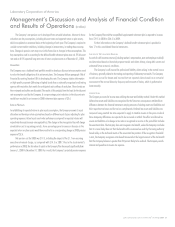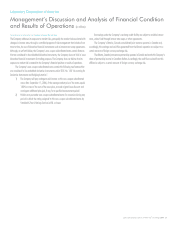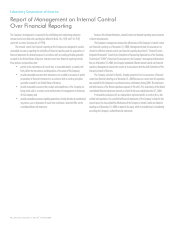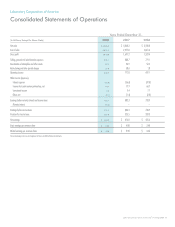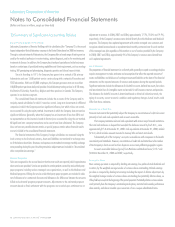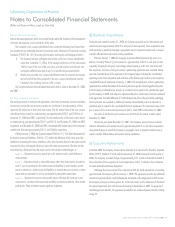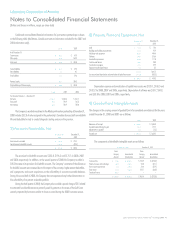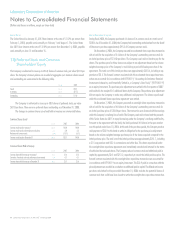LabCorp 2008 Annual Report Download - page 38
Download and view the complete annual report
Please find page 38 of the 2008 LabCorp annual report below. You can navigate through the pages in the report by either clicking on the pages listed below, or by using the keyword search tool below to find specific information within the annual report.Notes to Consolidated Financial Statements
(Dollars and shares in millions, except per share data)
Laboratory Corporation of America
36 Laboratory Corporation of America® Holdings 2008
1) Summary of Significant Accounting Policies
Basis of Financial Statement Presentation
Laboratory Corporation of America Holdings with its subsidiaries (the “Company”) is the second
largest independent clinical laboratory company in the United States based on 2008 net revenues.
Through a national network of laboratories, the Company offers a broad range of testing services
used by the medical profession in routine testing, patient diagnosis, and in the monitoring and
treatment of disease. In addition, the Company has developed specialty and niche businesses
based on certain types of specialized testing capabilities and client requirements, such as oncology
testing, HIV genotyping and phenotyping, diagnostic genetics and clinical research trials.
Since its founding in 1971, the Company has grown into a network of 36 primary
laboratories and over 1,600 patient service centers along with a network of branches and
STAT laboratories. With over 28,000 employees, the Company processes tests on more than
440,000 patient specimens daily and provides clinical laboratory testing services in all 50 states,
the District of Columbia, Puerto Rico, Belgium and three provinces in Canada. The Company
operates in one business segment.
The consolidated financial statements include the accounts of the Company and its
majority-owned subsidiaries for which it exercises control. Long-term investments in affiliated
companies in which the Company exercises significant influence, but which it does not control,
are accounted for using the equity method. Investments in which the Company does not exercise
significant influence (generally, when the Company has an investment of less than 20% and
no representation on the investee’s board of directors) are accounted for using the cost method.
All significant inter-company transactions and accounts have been eliminated. The Company
does not have any variable interest entities or special purpose entities whose financial results
are not included in the consolidated financial statements.
The financial statements of the Company’s foreign subsidiaries are measured using the
local currency as the functional currency. Assets and liabilities are translated at exchange rates
as of the balance sheet date. Revenues and expenses are translated at average monthly exchange
rates prevailing during the year. Resulting translation adjustments are included in “Accumulated
other comprehensive earnings.”
Revenue Recognition
Sales are recognized on the accrual basis at the time test results are reported, which approximates
when services are provided. Services are provided to certain patients covered by various third-party
payer programs including various managed care organizations, as well as the Medicare and
Medicaid programs. Billings for services under third party payer programs are included in sales
net of allowances for contractual discounts and allowances for differences between the amounts
billed and estimated program payment amounts. Adjustments to the estimated payment
amounts based on final settlement with the programs are recorded upon settlement as an
adjustment to revenue. In 2008, 2007 and 2006, approximately 17.7%, 18.3% and 19.9%,
respectively, of the Company’s revenues were derived directly from the Medicare and Medicaid
programs. The Company has capitated agreements with certain managed care customers and
recognizes related revenue based on a predetermined monthly contractual rate for each member
of the managed care plan regardless of the number or cost of services provided by the Company.
In 2008, 2007 and 2006, approximately 4% of the Company’s revenues were derived from
such capitated agreements.
Use of Estimates
The preparation of financial statements in conformity with generally accepted accounting principles
requires management to make estimates and assumptions that affect the reported amounts of
assets and liabilities and disclosure of contingent assets and liabilities at the date of the financial
statements and the reported amounts of revenues and expenses during the reported periods.
Significant estimates include the allowances for doubtful accounts, deferred tax assets, fair values
and amortization lives for intangible assets and accruals for self-insurance reserves and pensions.
The allowance for doubtful accounts is determined based on historical collections trends, the
aging of accounts, current economic conditions and regulatory changes. Actual results could
differ from those estimates.
Concentration of Credit Risk
Financial instruments that potentially subject the Company to concentrations of credit risk consist
primarily of cash and cash equivalents and accounts receivable.
The Company maintains cash and cash equivalents with various major financial institutions.
The total cash balances on deposit that exceeded the balances insured by the F.D.I.C., were
approximately $15.8 at December 31, 2008. Cash equivalents at December 31, 2008, totaled
$216.4, which includes amounts invested in treasury bills and short-term bonds.
Substantially all of the Company’s accounts receivable are with companies in the health
care industry and individuals. However, concentrations of credit risk are limited due to the number
of the Company’s clients as well as their dispersion across many different geographic regions.
Accounts receivable balances (gross) from Medicare and Medicaid were $115.7 and
$104.0 at December 31, 2008 and 2007, respectively.
Earnings Per Share
Basic earnings per share is computed by dividing net earnings, less preferred stock dividends and
accretion, by the weighted average number of common shares outstanding. Diluted earnings
per share is computed by dividing net earnings including the impact of dilutive adjustments by
the weighted average number of common shares outstanding plus potentially dilutive shares, as
if they had been issued at the beginning of the period presented. Potentially dilutive common shares
result primarily from the Company’s outstanding stock options, restricted stock awards, performance
share awards, and shares issuable upon conversion of zero-coupon subordinated notes.



